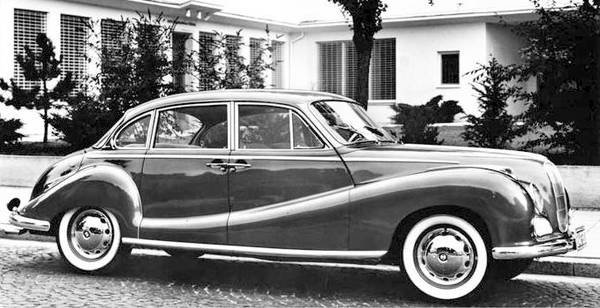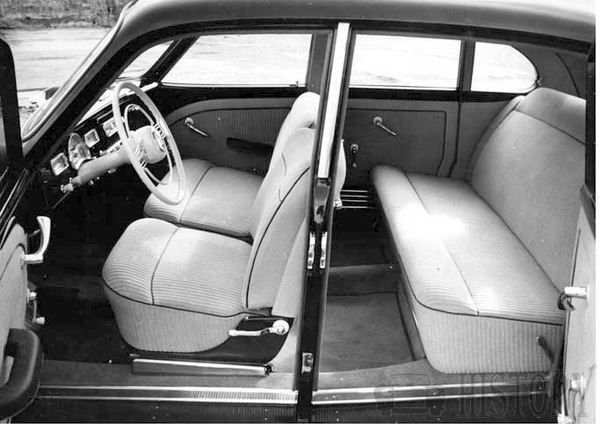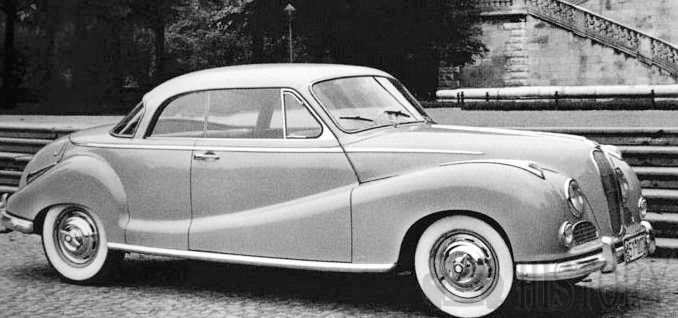BMW 502 and 3.2
| 1954 to 1964 | |
|---|---|
 | |
| Overview | |
| Manufacturer | Bayerische Motoren Werke AG (BMW) |
| Also called | BMW 2.6 Luxus BMW 2600L BMW 3.2 BMW 3.2 Super BMW 3200L BMW 3200S |
| Production | October 1954 - 1964 |
| Designer | Peter Schimanowski |
| Body and chassis | |
| Class | Full-size luxury car |
| Body style | 4-door saloon, 2-door cabriolet, 2-door coupé |
| Layout | FR layout |
| Related | BMW 501 BMW 503 BMW 507 BMW 3200 CS |
| Powertrain | |
| Engine | 2580 cc BMW OHV V8 3168 cc BMW OHV V8 |
| Transmission | 4-speed manual |
| Dimensions | |
| Wheelbase | 2,835 mm (111.6 in) |
| Length | 4,730 mm (186 in) |
| Width | 1,780 mm (70 in) |
| Height | 1,530 mm (60 in) |
| Kerb weight | 1,440 kg (3,170 lb) or more |
| Chronology | |
| Predecessor | BMW 335 |
| Successor | BMW 2500 / 2800 ‘New Six’ |
Before the construction of the first prototype of the 501, Böning had calculated the mass of the car as designed, and realized that the six-cylinder engine would be barely adequate to power the car. He proposed the development of a larger engine to power future versions of the car to the management, who accepted his proposal. Böning began the design and development of a V8 engine similar in general design to the then-new Oldsmobile Rocket V8, with a single camshaft in the vee operating overhead valves in wedge-shaped combustion chambers through pushrods. The BMW OHV V8 engine differed from its Detroit contemporaries in the use of an aluminium alloy block with cast-iron cylinder liners,and in its smaller size, initially with a 74 millimetres (2.9 in) bore and a 75 millimetres (3.0 in) stroke, giving a displacement of 2,580 cc (157 cu in). The development of the V8 was completed by Fritz Fiedler, who replaced Böning as BMW's chief engineer in 1952.
The V8 engine was introduced at the 1954 Geneva Motor Show as the engine of the new BMW 502 saloon car. Using the same chassis and basically the same body as the 501, the 502 was more luxuriously appointed and, with its light V8 engine producing 100 horsepower (75 kW) with a single two-barrel Solex carburettor, was much faster. The published top speed of 160 km/h (99 mph) was far higher than that of the first six-cylinder version of the Ponton Mercedes launched the same year. At the time of its introduction the 502 was reportedly Germany's fastest passenger sedan in regular production.
The 502 was acclaimed as Germany's first post-war V8 powered car, but its high price of DM17,800 led to low sales; only 190 were sold in its first year of production.
The 502 was distinguished from the 501 by additional chrome trim and more lavish interior fittings. Fog lights and individual front seats were also now included as standard features. The 502 was mildly restyled in 1955 with a wraparound rear window.
As well as the saloon version, BMW offered Baur built two-door cabriolet and coupé versions of the 502 in 1954 and 1955. 501s and 502s were also converted into ambulances and hearses.

The 1956 BMW 502 Interior view
BMW 2.6 and 2.6 Luxus
The 501 and 502 model designations were discontinued in 1958, when the 501 V8 was renamed the BMW 2.6 and the 502 was renamed the 2.6 Luxus. The cars were continued under these model designations until 1961 with only two notable changes: Power steering became an option in 1959, while front disc brakes were added in 1960.
BMW 2600 and 2600L
In 1961, the model designations were changed again, to 2600 and 2600L. The engine in the 2600L was tuned to give 110 horsepower (82 kW). Production ended in 1963.
BMW 3.2 and 3.2 Super
A further development of the V8 engine was introduced at the 1955 Frankfurt Motor Show. This had a 82 millimetres (3.2 in) bore, giving a capacity of 3,168 cc (193.3 cu in). The engine made its debut in four new cars at the show, the 507 two-seat convertible, the 503 coupe, the 505 limousine prototype, and the BMW 3.2, a development of the 502 that did not have a model number and was identified simply by its displacement in litres. As used in the 3.2 and the 505, the engine had a compression ratio of 7.2:1, up from the 7.0:1 of the original 2.6 L V8 engine. In this tune, the engine yielded 120 horsepower (89 kW) The final drive ratio was raised from 4.225:1 on the smaller-engined sedans to 3.89:1 on the 3.2 to reduce the fuel consumption of the larger engine.
In 1957, the 3.2 Super with a 140 horsepower (100 kW) engine, was released. The 3.2 and 3.2 Super were continued under these model designations until 1961 with only two notable changes: Power steering became an option in 1959, while front disc brakes were added to the 3.2 Super in October 1959 and to the 3.2 in 1960.
BMW 3200L and 3200S
In 1961, the 3.2 and 3.2 Super were replaced by the 3200L and 3200S respectively. The 3200L had a single carburettor engine that produced 140 horsepower (100 kW), while the 3200S had a twin carburettor engine that produced 160 horsepower (120 kW) at 5600 revolutions per minute.
A report on a 3.2-litre BMW saloon estimated the 502's consumption at 15 L/100 km (19 mpg-imp; 16 mpg-US).
Production ended in 1963.
Other developments
BMW 503 and 507
The BMW 503 and 507 were grand touring cars; the 503 was a four-seat coupé or convertible while the 507 was a two-seat convertible. Conceived by US importer Max Hoffman, designed by German-American designer Albrecht von Goertz, and engineered by Fritz Fiedler, the 503 and 507 used variations of a chassis specially designed for them, along with reworked twin carburettor versions of the 3.2 engines. They were supposed to be priced at about five thousand dollars in the United States and be sold in the thousands by Hoffman. Instead, the 503 and 507 ended up being priced at about ten thousand dollars, and only 412 and 252, respectively, were sold.
BMW 505 prototype
The Frankfurt Show in 1955 saw the presentation of the BMW 505, a limousine based on the new 3.2 saloon. Styled by Giovanni Michelotti, the 505 was 5.1 metres long, with a wheelbase of about 3.1 metres. Konrad Adenauer, the Chancellor of West Germany, tried out the 505. It is reported that, on entering the car, Adenauer knocked his hat off. Regardless of the reason, Adenauer continued to use the Mercedes-Benz 300 as his official car to the extent that the type acquired the nickname “Adenauer Mercedes”. The BMW 505 never went into series production, and only two prototypes were built.

1954 BMW 502 Coupe
Rating
Technical
-
BMW 3200L technical details and specifications 1955 – 1962
BODY: saloon; doors: 4; seats: 6; front seat: double, adjustable backrests.
ENGINE:
ENGINE CAPACITY: 193.75 cu in, 3168 cu cm
front, 4 stroke; cylinders: 8, Vee-slanted at 900
bore and stroke 3.23 x 2.95 in, 82 x 75 mm
engine capacity: 193.75 cu in, 3168 cu cm
compression ratio: 9 : 1
max power (DIN): 140 hp at 5400 rpm
max torque (DIN): 175 1b ft, 24.2 kgm at 3000 rpm
max number of engine rpm: 5800
specific power: 44.1 hp/l
cylinder block: light alloy, wet liners
cylinder head: light alloy
crankshaft bearings: 5
valves: 2 per cylinder, overhead, in line, with push rods and rockers camshaft: 1, at centre of Vee
lubrication: gear pump, full flow filter, oil cooler
lubricating system capacity: 5.7 imp qt, 6.9 US qt, 6.5 1
carburation: 1 Zenith 36 NDIX twin-barrel downdraft carburettor
fuel feed: mechanical pump; cooling system: water
TRANSMISSION:
driving wheels: rear
clutch: single dry plate, hydraulically controlled
gear box: mechanical
gears: 4 + reverse
synchromesh gears: l, IV; gear box ratios: (I) 3.71, (II) 2.27, (III) 1.49, (IV) 1, (Rev) 3.49
gear lever: steering column
final drive: hypoid bevel
ratio: 3.89 : 1.CHASSIS:
box-type long members, tubular cross members
front suspension: independent, wishbones, adjustable trailing torsion bars, telescopic dampers
rear suspension: rigid axle, radius arms, adjustable trailing torsion bars, upper A-bracket, telescopic dampers.STEERING:
bevel gears
turns of steering wheel lock to lock: 3.25.BRAKES:
front disc, rear drum, vacuum servo
braking surface: front 15.81 sq in, 102 sq cm, rear 97.34 sq in, 628 sq cm, total 113.15 sq in, 730 sq cm.ELECTRICAL EQUIPMENT:
voltage: 12 V
battery: 56 Ah
dynamo: 160 W;
ignition distributor: Bosch
headlights: 2 front and reversing.DIMENSIONS AND WEIGHT:
wheel base: 111.61 in, 2834 mm
front track: 52.36 in, 1330 mm
rear track: 55.75 in, 1416 mm
overall length: 185.22 in, 4730 mm;
overall width: 70.08 in, 1780 mm
overall height: 60.24 in, 1530 mm
ground clearance: 6.89 in, 175 mm
dry weight: 3219 1b, 1460 kgfuel tank capacity: 15.39 imp gal, 18.49 US gal, 70 1.
width of rims: 4.5" •PERFORMANCE:
FUEL CONSUMPTION: 21.4 m/imp gal, 17.8 m US gal, 13.2 | x 100 km;
MAX SPEED: 108.7 mph, 175 km/h
max speed in 1st gear: 26.7 mph, 43 km/h
max speed in 2nd gear: 46.6 mph, 75 km/h
max speed in 3rd gear: 74.6 mph, 120 km/h
max speed in 4th gear: 108.7 mph, 175 km/h
power-weight ratio: 22.9 lb/hpProduction figures
Series Years built Units manufactured 502 and 2.6 L derivatives 502 / 2.6 Luxus / 2600L 1954 – 1962 3,117 3.2 L derivatives 3.2 / 3200L 1955 – 1962 2,537 3.2 Super / 3200S 1957 – 1963 1,328 Coupe and roadster derivatives 503 1956 – 1959 412 507 1956 – 1959 253 3200 CS 1962 – 1965 603
-
Service details: BMW 3200L (1955–1962)
fuel: petrol, 95-100 Oct
engine sump oil: 5.3 imp qt,6.3 US qt, 6.0 1, SAE 10 W-30, change every 3700 miles, 6000 km
gearbox 1.23 imp qt, 1.48 US qt, 1.4 1, SAE 90, change every 7500 miles, 12000
final drive oil: 1.41 imp qt, 1.69 US qt, 1.6 1, SAE 90, change every 7500 miles, 12000 km
cooling system capacity: 9.7 imp qt, 11.6 US qt, 11 1.
greasing: every 3700 miles, 6000 km, 9 points
spark plug type: 2250
tappet clearances: inlet 0.010 in, 0.25 mm, exhaust 0.010 in, 0.25 mm
valve timing: (inlet) opens 17 ° before tdc and closes 52 ° after bdc, (exhaust) opens 52 ° before bdc and closes 17 ° after tdc
tyre pressure (medium load): front 28 psi, 2 atm, rear 33 psi, 2.3 atm.




